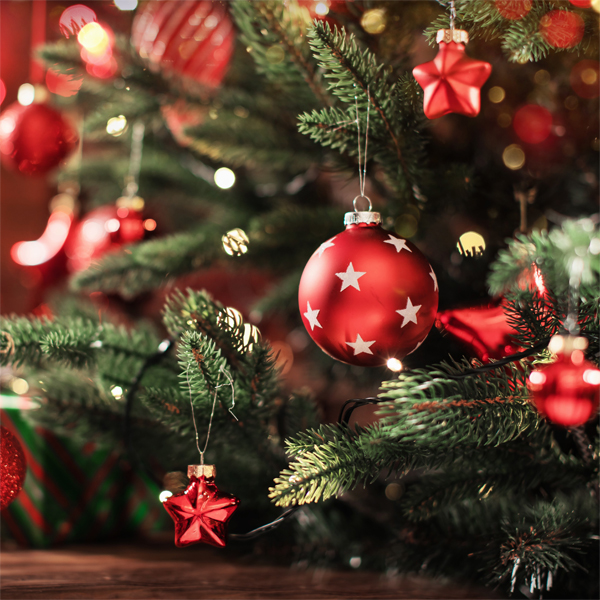Before Christmas trees were considered essential decor for the holidays, they were simply fragrant evergreens that served as a source of joy during the harsh winter months. Here, we’ll take you through the most useful—and interesting—Christmas tree history to dazzle guests with at your annual holiday party.
What does the Christmas tree symbolize?
In ancient cultures, the winter solstice was heralded as the beginning of brighter days ahead, an indication that the sun god was regaining his strength. Evergreen trees, of course, retained their color through all seasons, and thus were displayed and embraced in coordination with the solstice as a reminder of warmer months.
In Egypt, a similar mindset was adopted. The Sun God, Ra, typically grew weak as conditions became colder and darker. The solstice was seen as the turning point in seasons, so Egyptians decorated their homes with palm leaves and branches. Similarly, in ancient Rome, a feast called Saturnalia was held during the solstice, which also encouraged people to celebrate the springtime (and bountiful harvest) ahead with evergreen decorations.
When did Christmas trees originate?
The true Christmas tree tradition can be traced to 16th-century Germany, where Christians began to decorate trees—or, if times were tough, simple pyramid-shaped stacks of wood— inside their homes. The tradition of adding candles to the tree branches is most commonly attributed to Martin Luther, leader of the Protestant Reformation movement in the 1500s. (Legend suggests he was inspired by the stars in the night sky and wanted to re-create the scene in his own home using candlelight.)
According to A Christmas Cornucopia: The Hidden Stories Behind Our Yuletide Traditions, the first-ever Christmas tree was in London, near what is now Leadenhall Market. However, it seems it was a one-time trend, as Christmas trees wouldn’t be back in Britain until the 19th century.
In what country did the Christmas tree originate? And are Christmas trees religious?
Despite the Christmas tree’s roots in Christianity, most Americans refused to adopt the tradition at first because they believed it to be attached to pagan beliefs. The tradition was mostly contained to Germany until the late 1700s and early 1800s. Until then, the Puritans of New England upheld especially strict views of Christmas in America, and people were severely punished if they celebrated or decorated in any way. (They believed the holiday was so sacred that a church service was the only appropriate way to celebrate.) This solemn American observance of Christmas continued until Irish and German immigrants began to make their way across the Atlantic and established their own traditions despite the Puritan rule.
German settlements, particularly in Pennsylvania, typically decorated community trees in the late 18th century, and soon the trees found their way into the individual homes of German families—but most of the country was still skeptical. It wasn’t until England’s Queen Victoria and Prince Albert (who was of German heritage) were depicted in a popular newspaper in 1848 standing around a Christmas tree with their family that the tradition became more widely embraced. Americans were hereby convinced that Christmas trees were desirable holiday decorations.
Where did the custom of decorating Christmas trees originate?
Other than the candle aesthetic already established in Europe, decorations like ornaments (often imported from Germany) became more popular in the late 1800s, and homemade decorations like cookies and garlands (think: popcorn, berries, nuts, and more) became decorating staples.
These more homespun decorations gave way to electric lights and synthetic materials, like tinsel, as technological and industrial developments changed throughout the 20th century. The popular Shiny Brite ornaments, inspired by imported German glass ornaments, marked the beginning of the U.S. ornament industry in the early-to-mid 1900s.
Where does the National Christmas tree come from?
In 1923, President Calvin Coolidge started the White House’s National Christmas tree-lighting tradition with a 48-foot Balsam Fir brought to Washington, D.C., from Vermont. The annual ceremony continues today, and the tree, a blue spruce grown in Virginia, is now planted on the north side of the Ellipse at the White House.
Where does the Rockefeller Center Christmas tree come from?
In 1931, a simple tree was placed in the middle of Rockefeller Center in Manhattan, New York. Soon after, it became a tradition similar to the White House tree to signify the start of the holiday season in New York City. This tree is typically a Norway spruce selected by the head gardener at Rockefeller Center and is selected from submissions sent in each year.
BY COUNTRY LIVING STAFF
Christmas Trees Around the World
Canada: German settlers migrated to Canada from the United States in the 1700s. They brought with them many of the things associated with Christmas we cherish today—Advent calendars, gingerbread houses, cookies—and Christmas trees. When Queen Victoria’s German husband, Prince Albert, put up a Christmas tree at Windsor Castle in 1848, the Christmas tree became a tradition throughout England, the United States, and Canada.
Mexico: In most Mexican homes the principal holiday adornment is el Nacimiento (Nativity scene). However, a decorated Christmas tree may be incorporated in the Nacimiento or set up elsewhere in the home. As purchase of a natural pine represents a luxury commodity to most Mexican families, the typical arbolito (little tree) is often an artificial one, a bare branch cut from a copal tree (Bursera microphylla) or some type of shrub collected from the countryside.
Great Britain: The Norway spruce is the traditional species used to decorate homes in Britain. The Norway spruce was a native species in the British Isles before the last Ice Age, and was reintroduced here before the 1500s.
Greenland: Christmas trees are imported, as no trees live this far north. They are decorated with candles and bright ornaments.
Guatemala: The Christmas tree has joined the “Nacimiento” (Nativity scene) as a popular ornament because of the large German population in Guatemala. Gifts are left under the tree on Christmas morning for the children. Parents and adults do not exchange gifts until New Year’s Day.
Brazil: Although Christmas falls during the summer in Brazil, sometimes pine trees are decorated with little pieces of cotton that represent falling snow.
Ireland: Christmas trees are bought anytime in December and decorated with colored lights, tinsel, and baubles. Some people favor the angel on top of the tree, others the star. The house is decorated with garlands, candles, holly, and ivy. Wreaths and mistletoe are hung on the door.
Sweden: Most people buy Christmas trees well before Christmas Eve, but it’s not common to take the tree inside and decorate it until just a few days before. Evergreen trees are decorated with stars, sunbursts, and snowflakes made from straw. Other decorations include colorful wooden animals and straw centerpieces.
Norway: Nowadays Norwegians often take a trip to the woods to select a Christmas tree, a trip that their grandfathers probably did not make. The Christmas tree was not introduced into Norway from Germany until the latter half of the 19th century; to the country districts it came even later. When Christmas Eve arrives, there is the decorating of the tree, usually done by the parents behind the closed doors of the living room, while the children wait with excitement outside. A Norwegian ritual known as “circling the Christmas tree” follows, where everyone joins hands to form a ring around the tree and then walk around it singing carols. Afterwards, gifts are distributed.
Ukraine: Celebrated on December 25th by Catholics and on January 7th by Orthodox Christians, Christmas is the most popular holiday in the Ukraine. During the Christmas season, which also includes New Year’s Day, people decorate fir trees and have parties.
Spain: A popular Christmas custom is Catalonia, a lucky strike game. A tree trunk is filled with goodies and children hit at the trunk trying to knock out the hazel nuts, almonds, toffee, and other treats.
Italy: The presepio (manger or crib) represents in miniature the Holy Family in the stable and is the center of Christmas for families. Guests kneel before it and musicians sing before it. The presepio figures are usually hand-carved and very detailed in features and dress. The scene is often set out in the shape of a triangle. It provides the base of a pyramid-like structure called the ceppo. This is a wooden frame arranged to make a pyramid several feet high. Several tiers of thin shelves are supported by this frame. It is entirely decorated with colored paper, gilt pine cones, and miniature colored pennants. Small candles are fastened to the tapering sides. A star or small doll is hung at the apex of the triangular sides. The shelves above the manger scene have small gifts of fruit, candy, and presents. The ceppo is in the old Tree of Light tradition which became the Christmas tree in other countries. Some houses even have a ceppo for each child in the family.
Germany: Modern Tannenbaum (Christmas trees) are traditionally decorated in secret with lights, tinsel and ornaments by parents and then lit and revealed on Christmas Eve with cookies, nuts and gifts under its branches.
South Africa: Christmas is a summer holiday in South Africa. Although Christmas trees are not common, windows are often draped with sparkling cotton wool and tinsel.
Saudi Arabia: Christian Americans, Europeans, Indians, Filipinos, and others living here have to celebrate Christmas privately in their homes. Christmas lights are generally not tolerated. Most families place their Christmas trees somewhere inconspicuous.
Philippines: Fresh pine trees are too expensive for many Filipinos, so handmade trees in an array of colors and sizes are often used. Star lanterns, or parol, appear everywhere in December. They are made from bamboo sticks, covered with brightly colored rice paper or cellophane, and usually feature a tassel on each point. There is usually one in every window, each representing the Star of Bethlehem.
China: Of the small percentage of Chinese who do celebrate Christmas, most erect artificial trees decorated with spangles and paper chains, flowers, and lanterns. Christmas trees are called “trees of light.”
Japan: For most of the Japanese who celebrate Christmas, it’s purely a secular holiday devoted to the love of their children. Christmas trees are decorated with small toys, dolls, paper ornaments, gold paper fans and lanterns, and wind chimes. Miniature candles are also put among the tree branches. One of the most popular ornaments is the origami swan. Japanese children have exchanged thousands of folded paper “birds of peace” with young people all over the world as a pledge that war must not happen again.
By the Editors of History.com








